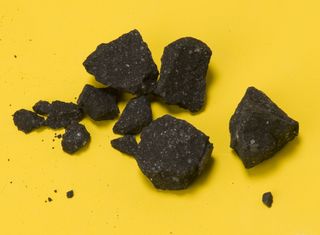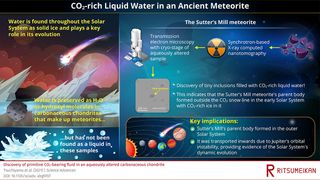Scientists find liquid water inside a meteorite, revealing clues about the early solar system

Scientists have spotted water in a primitive meteorite, expanding our understanding of the ancient solar system.
Water is abundant in our solar system — from the icy rings of Saturn to the subsurface water on its moon Enceladus and the liquid water and ice detected on Mars, water is known to exist beyond Earth. However, while scientists have suspected that water is preserved in a type of meteorite known as carbonaceous chondrites, they have never discovered liquid water in these rocks — until now.
In a new study, researchers detected small pockets of carbon dioxide-rich liquid water in a meteorite hailing from the early solar system. This new work is expanding our understanding of how planets evolved in our solar system as this type of meteorite water could have contributed to water on planet Earth long ago.
The discovery of water in this space rock "gives the direct evidence of dynamic evolution of the solar system," study author Akira Tsuchiyama, a visiting research professor at Ritsumeikan University in Japan, told Space.com in an email.
Related: Meteorite from brilliant UK fireball is England's first in 30 years

Tsuchiyama and their colleagues took a close look at fragments from the Sutter's Mill meteorite, which formed 4.6 billion years ago and fell to Earth in 2012, landing in the United States. Many pieces of the meteorite were recovered near the Sutter's Mill gold rush site near Sacramento, California.
They used microscopy techniques to look at the fragments and noticed a tiny calcite crystal harboring an even smaller (think nanoscale) liquid containing at least 15% carbon dioxide. This finding confirmed that both liquid water and also carbon dioxide can exist in ancient space rocks.
Get the Space.com Newsletter
Breaking space news, the latest updates on rocket launches, skywatching events and more!
"This achievement shows that our team could detect a tiny fluid trapped in a mineral 4.6 billion years ago," Tsuchiyama said in a statement.
The researchers think that the parent asteroid of this smaller space rock likely formed with frozen water and carbon dioxide, meaning it had to have formed in a cold part of the solar system (most likely beyond Jupiter's orbit), only later making its way to Earth. This lines up with some previous theories that have suggested that asteroids rich in molecules like water formed far out in the solar system before traveling closer to the sun, according to the statement.
The researchers also think that their findings could help to inform the search for the origins of Earth's water.
There are many theories about where and how Earth got its water. One of the leading theories suggests that water fell to Earth, trapped inside objects like meteorites (specifically, carbonaceous chondrites). According to this theory, water molecules incorporated in the crystal structures of minerals in these space rocks could be a source of Earth's water, Tsuchiyama explained.
Now, while "the amount of liquid water found in the present study is very small," Tsuchiyama said, the study "gives the evidence for the presence of such liquid water."
"In other words," they added," if the water in those minerals contributed to Earth's water, then it can be considered the "parent" of Earth's water, and the meteorites hosting these minerals, therefore, the "grandparent material of Earth's water."
This work was described in a study published April 21 in the journal Science Advances.
Email Chelsea Gohd at cgohd@space.com or follow her on Twitter @chelsea_gohd. Follow us on Twitter @Spacedotcom and on Facebook.
Join our Space Forums to keep talking space on the latest missions, night sky and more! And if you have a news tip, correction or comment, let us know at: community@space.com.

Chelsea “Foxanne” Gohd joined Space.com in 2018 and is now a Senior Writer, writing about everything from climate change to planetary science and human spaceflight in both articles and on-camera in videos. With a degree in Public Health and biological sciences, Chelsea has written and worked for institutions including the American Museum of Natural History, Scientific American, Discover Magazine Blog, Astronomy Magazine and Live Science. When not writing, editing or filming something space-y, Chelsea "Foxanne" Gohd is writing music and performing as Foxanne, even launching a song to space in 2021 with Inspiration4. You can follow her on Twitter @chelsea_gohd and @foxannemusic.












